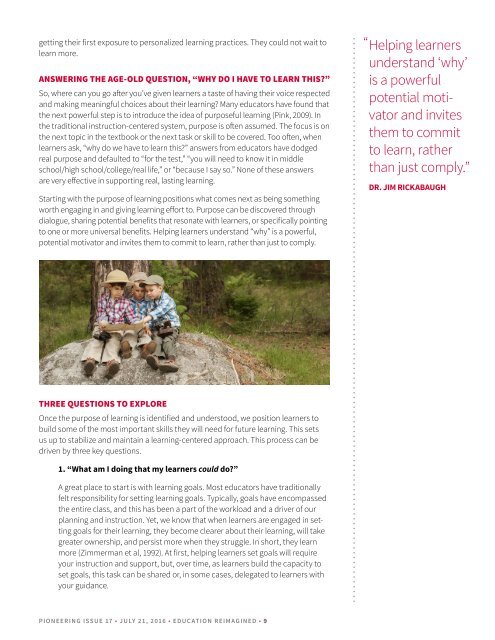pioneering
GUOH302uhdw
GUOH302uhdw
You also want an ePaper? Increase the reach of your titles
YUMPU automatically turns print PDFs into web optimized ePapers that Google loves.
getting their first exposure to personalized learning practices. They could not wait to<br />
learn more.<br />
ANSWERING THE AGE-OLD QUESTION, “WHY DO I HAVE TO LEARN THIS?”<br />
So, where can you go after you’ve given learners a taste of having their voice respected<br />
and making meaningful choices about their learning? Many educators have found that<br />
the next powerful step is to introduce the idea of purposeful learning (Pink, 2009). In<br />
the traditional instruction-centered system, purpose is often assumed. The focus is on<br />
the next topic in the textbook or the next task or skill to be covered. Too often, when<br />
learners ask, “why do we have to learn this?” answers from educators have dodged<br />
real purpose and defaulted to “for the test,” “you will need to know it in middle<br />
school/high school/college/real life,” or “because I say so.” None of these answers<br />
are very effective in supporting real, lasting learning.<br />
Starting with the purpose of learning positions what comes next as being something<br />
worth engaging in and giving learning effort to. Purpose can be discovered through<br />
dialogue, sharing potential benefits that resonate with learners, or specifically pointing<br />
to one or more universal benefits. Helping learners understand “why” is a powerful,<br />
potential motivator and invites them to commit to learn, rather than just to comply.<br />
“ Helping learners<br />
understand ‘whyʼ<br />
is a powerful<br />
potential motivator<br />
and invites<br />
them to commit<br />
to learn, rather<br />
than just comply.”<br />
DR. JIM RICKABAUGH<br />
THREE QUESTIONS TO EXPLORE<br />
Once the purpose of learning is identified and understood, we position learners to<br />
build some of the most important skills they will need for future learning. This sets<br />
us up to stabilize and maintain a learning-centered approach. This process can be<br />
driven by three key questions.<br />
1. “What am I doing that my learners could do?”<br />
A great place to start is with learning goals. Most educators have traditionally<br />
felt responsibility for setting learning goals. Typically, goals have encompassed<br />
the entire class, and this has been a part of the workload and a driver of our<br />
planning and instruction. Yet, we know that when learners are engaged in setting<br />
goals for their learning, they become clearer about their learning, will take<br />
greater ownership, and persist more when they struggle. In short, they learn<br />
more (Zimmerman et al, 1992). At first, helping learners set goals will require<br />
your instruction and support, but, over time, as learners build the capacity to<br />
set goals, this task can be shared or, in some cases, delegated to learners with<br />
your guidance.<br />
PIONEERING ISSUE 17 • JULY 21, 2016 • EDUCATION REIMAGINED • 9


